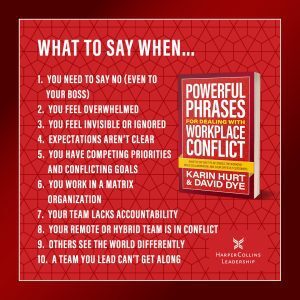David Dye's Blog, page 20
May 27, 2024
Why “Agree to Disagree” Stinks and What to Say Instead for Better Work Relationships
Faced with conflict at work, you might think “let’s agree to disagree” is an easy way to move on from the conversation. The words seem peaceful and hint at mutual respect. But in actual use, they aren’t peaceful, or helpful, at all.
The phrase implies a deadlock, which can prevent the resolution of underlying issues and hinder productive work relationships. Instead, you can use a few powerful phrases to create more collaborative conversations, solve problems, and build better relationships.
You won’t always agree, but there’s a better way to disagree.
Why “Agree to Disagree” is TroublePresumptuous Disrespect:When you say, “let’s agree to disagree,” you are telling the other person what they will do – without their agreement, input, or consideration of their perspective. That’s presumptuous (assuming you know best) and dismissive, implying that further dialogue is pointless and that the other person’s viewpoint isn’t worth considering.
Avoidance of Resolution:“Agree to disagree” often halts further discussion and doesn’t address the root causes of disagreement. Unresolved issues will surface again in ongoing tension and conflict.
Lack of Understanding:Agreeing to disagree prevents you from fully understanding each other’s perspectives. This understanding is crucial for to build empathy, find common ground, and give you a chance at a solution.
Missed Opportunities for Innovation:Collaborative disagreement is a source of creativity and innovation. Avoiding these discussions prevents teams from exploring diverse ideas that could lead to better solutions.
What to Say Instead of “Agree to Disagree”When you have a serious disagreement with a coworker, rather than jumping straight to “agree to disagree,” you can use a few powerful phrases that open the door to better understanding, solutions, and improved relationships.
These G.O.A.T. (Greatest of All Time) phrases are rooted in the four dimensions of productive conflict: Connection, Clarity, Curiosity, and Commitment.
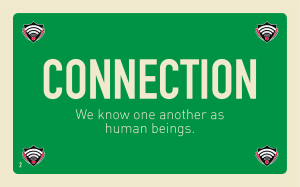 Connection—Do you know one another as human beings?
Connection—Do you know one another as human beings?Every conflict is an opportunity to build a better relationship. Don’t lose the chance to connect by pushing someone away with “agree to disagree.” Here are some phrases you can use to “see” the other person and enhance connection:
“I care about [you/this team/this project], and I’m confident we can find a solution that works for all of us.” This phrase acknowledges the challenge while expressing confidence in a collaborative solution.
“Tell me more.” This is the complete opposite of “agree to disagree.” This simple but powerful phrase helps you learn more about the other person and helps them feel seen and heard.
“It sounds like you’re feeling [emotion], is that right? Thank you for letting me know how you feel.” This technique, known as “reflect to connect,” validates the other person’s feelings and builds rapport.
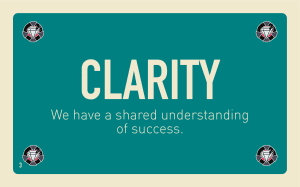
So many workplace conflicts are misunderstandings. If you jump straight to “agree to disagree,” you lose the opportunity to create more clarity and truly solve problems. Here are a few phrases to help you build that shared understanding.
“What would a successful outcome do for you?” This question helps identify the desired end result, opening up possibilities for mutual understanding, collaboration, and solutions that can satisfy both of your needs.
“Can we start with what we agree on?” Finding common ground can reduce tension and create a cooperative atmosphere.
“What I’m hearing you say is [paraphrase]. Do I have that right?” This check for understanding ensures both parties are on the same page and can clear up any misinterpretations.
Another approach is “Here’s what I’m hearing you say so far. Please correct me where I’m wrong.” Then give your summary.
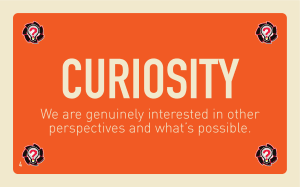
The more you learn about other people’s perspectives, approaches, and experience, the easier time you’ll have collaborating and solving problems. But you won’t know if you don’t ask. Here are some curiosity phrases to use instead of “agree to disagree.”
“I’m curious how this looks from your perspective.” This straightforward phrase acknowledges that different perspectives exist. It’s so far from “agree to disagree” because it creates dialogue rather than shut it down.
“What do you suggest we do next?” Moving the conversation towards actionable steps helps you find solutions.
“What can I do to support you right now?” Offering support shows a willingness to help and can de-escalate tension.
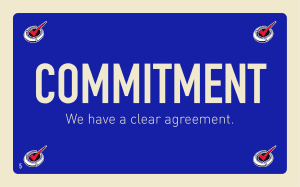 Commitment—Do you have a clear agreement?
Commitment—Do you have a clear agreement?As you learn from one another, now you are in more of a position to move forward (rather than jumping straight to the presumptive “agree to disagree”). Focus on specific commitments to help move forward constructively:
“What’s one action we can both agree to as a next step?” This question narrows down the discussion to practical steps that can be taken immediately and looks for common ground.
“So, to recap our conversation, we’ve agreed to [summarize]. Is that your understanding?” Recapping ensures you both have a clear understanding of the agreements made, preventing future conflicts.
“Let’s schedule some time to talk about this again and see how our solution is working.” Scheduling a follow-up ensures continued commitment to resolving the issue and adjusting as necessary. Another anti-“agree to disagree” this phrase keeps the conversation going and keeps you engaged with one another.
Examples of Powerful Phrases in ActionConsider the following scenarios where these powerful phrases can replace “agree to disagree” and lead to more productive outcomes:
Scenario: Team Conflict Over Project DirectionOriginal: “Let’s just agree to disagree and move on.”
Alternative: “I care about our project’s success and I’m confident we can find a solution that works for all of us. What would a successful outcome do for you?”
Scenario: Disagreement on Work ProcessesOriginal: “We’ll never see eye to eye on this, so let’s agree to disagree.”
Alternative: “It sounds like you’re feeling frustrated with our current process. Do I have that right? Let’s start with what we agree on and see how we can address the differences.”
Scenario: Conflict Between Team MembersOriginal: “We’ll just have to agree to disagree on this.”
Alternative: “I’ve noticed that we have different points of view on this issue and would love to learn more. How does this look from your perspective? What can we do next to move forward?”
But What About…There might be a time where you can’t resolve differences or find a solution that meets everyone’s needs. (Less often than you might think, but it does happen.)
Especially in those moments, investing in connection, clarity, curiosity, and commitment is vital to build mutual respect and a collaborative relationship. Here are a few more phrases you can use in these times:
“So what you’re saying is… Do I have that right? That’s interesting. And I see it differently.” With this phrase, you create clarity with a check for understanding to ensure you have heard the other person. And you also affirm your own perspective—without telling them what they have to do or not do.
“I don’t expect either of us to change our mind about… Can we agree to…?” The key here is a constructive forward step—not “Can we agree to disagree”—that’s not constructive. For example, you might say, “Can we agree to respect one another and work together on this project in a way that serves our customers?”
Your TurnThere are so many ways to build your work relationships and find better solutions than telling someone, “Let’s agree to disagree.”
We’d love to hear from you: How does this look from your perspective? What is one of your most effective phrases when you face a serious disagreement at work?
(And if you want more powerful phrases to help with your most common workplace conflicts, check out Powerful Phrases for Dealing with Workplace Conflict):
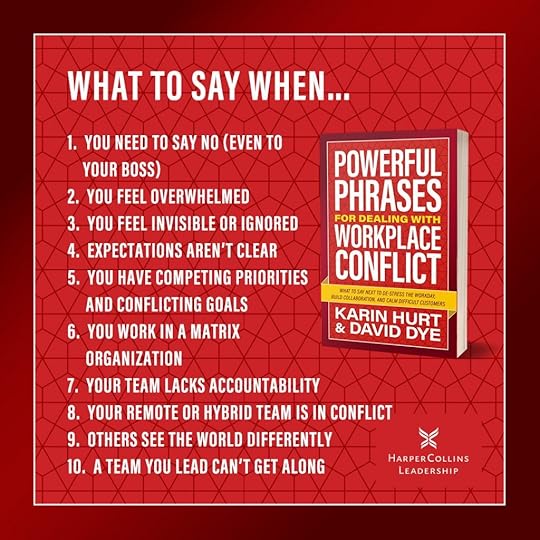
Click here for FREE Sample Chapters
The post Why “Agree to Disagree” Stinks and What to Say Instead for Better Work Relationships appeared first on Let's Grow Leaders.
May 24, 2024
Human Connection: How Do I Train Someone to Connect More Deeply?
“Hey Karin, I was just in your and David’s session at the Association for Talent Development (ATD) Global Conference in New Orleans, where you talked about human connection and the 4 dimensions of productive conflict (collaboration): connection, clarity, curiosity, and commitment.
conflict (collaboration): connection, clarity, curiosity, and commitment.
And I’ve got to tell you. There are a few people on my team who struggle with connection. How can I train someone to connect? #AskingforaFriend
Let’s start here few connection habits from our new SynergyStack System. These habits are designed to be easy to implement and can help build stronger, more meaningful connections in the workplace.

When someone is more task-focused, the last thing they want to hear is that they need to “be more connected.” That can feel vague and overwhelming. What I find works better is to break the job of connecting into practical tangible habits (you might even call them “tasks”) that people can practice.
If you’re naturally great at connecting, this can feel silly, but trust me, I’ve helped many people pick a few habits and put connecting on their “to-do” list. Task-oriented people are normally great at getting stuff done once they know what to do.
Start with just one or two habits and encourage the person you are looking to train on building human connection to schedule time on their calendar to do this.
For example, a good time to practice the “care about you” habit would be in a one-on-one or staff meeting. So they could just add “CAY (for Care About You)” to those appointments on their calendar as a reminder.
Or perhaps there’s a company event coming up, where you could encourage them to consider how they will use that time to get to know two people better by asking about their people, pets, or projects.
Once they’ve agreed to experiment with a few habits, the next step is to “schedule the finish” and pick a time where they can share what they did and the impact they had. If they know they have time on the calendar to talk wth you about this again, they are more likely to follow-through. Plus reflecting on the process will help reinforce the habit. And of course, this gives you a scheduled time to encourage, reinforce, and discuss how they will keep the progress going.
5 Important Habits That Help People Connect1. I care about you and show you in my words and actions.Empathy is a bridge to deeper understanding and trust. When you genuinely recognize and respond to the emotions of team members, it creates a safe space for open dialogue and vulnerability.
You can kick-start a supportive conversation with: “It sounds like you’re really frustrated…”
2. I take time to learn about your people, pets, and projects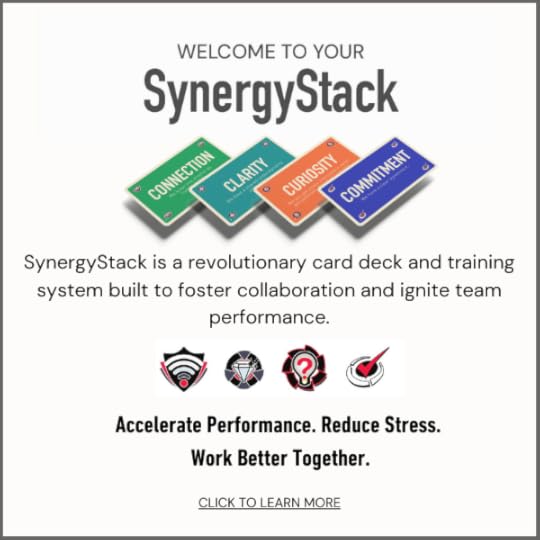 For better teamwork, dive deeper than just professional interactions. When you understand someone’s life, it’s easier to understand their perspectives and motivations at work. Ask about hobbies, families, and dreams.
For better teamwork, dive deeper than just professional interactions. When you understand someone’s life, it’s easier to understand their perspectives and motivations at work. Ask about hobbies, families, and dreams.
Kick off a chat with questions like: “How’s your new puppy? Is she eating your dirty socks?”
3. I find a way to play—to energize our teamwork and lighten the load.During tight deadlines and serious discussions, a little levity can go a long way in building better teamwork and fostering connection. Laughter can reduce stress and increase creativity.
Break the monotony and propose a lighter approach: “What if we gamified this?”
4. I work to help you succeed. Your win is my win.When team members support one another, they amplify their collective potential.
Show your commitment to their success with: “How can I be most helpful?”
Your turn.
What’s one of your favorite habits for fostering human connection? And how do you train someone who struggles to connect well?
The post Human Connection: How Do I Train Someone to Connect More Deeply? appeared first on Let's Grow Leaders.
Helpful Tips for Working with an Indecisive Manager
Episode 258: In this episode, David Dye explores the all-too-common frustration of working with an indecisive manager. He shares practical strategies that you can use to navigate this challenging situation. David suggests using powerful phrases to pinpoint where your boss is getting stuck and to gain clarity on the decision-making process. He also advises demonstrating to your boss that acting is often easier than remaining in the status quo. He suggests making decisions feel less permanent by proposing a trial or pilot run.
David highlights the importance of prioritizing what’s best for the organization and its stakeholders. He encourages you to persist in your conversations with your indecisive boss. Additionally, David announces the launch of the new book, “Powerful Phrases for Dealing with Workplace Conflict,” and encourages you to leave a review to help spread the word.
Understanding Your Indecisive Manager00:00 – 02:00 In this episode, we’re diving into the frustration of working with an indecisive manager. You know, the kind who postpones every single decision. We’ve all been there, right? Today, we’ll talk about what you can do to help your boss decide and move forward.
02:01 – 04:00 It’s important to recognize why your indecisive manager might be stalling. They could be dealing with issues they can’t talk about yet or managing multiple stakeholders. Maybe they’re just scared of getting something wrong. Understanding the root cause is the first step.
04:01 – 06:00 Use powerful phrases to get to the bottom of your manager’s hesitation. Try asking, “What’s causing your hesitation here?” or “Who else needs to be involved in this decision?” These questions can help you understand where they’re stuck and move the conversation forward.
06:01 – 08:00 Once you’ve identified the hesitation, invest in clarity. Present your ideas clearly and concisely. Explain the options and recommend a course of action. For example, “I see two options: Option A and Option B. I recommend Option A because…” This helps your indecisive manager see the path forward.
Overcoming Decision Paralysis08:01 – 10:00 Sometimes, indecisive managers are afraid of change because it seems like too much work. Show them that moving forward with your plan is easier than sticking with the status quo. This can help them get unstuck.
10:01 – 12:00 Make the decision feel less permanent by suggesting a trial or pilot run. This way, a bigger decision feels smaller and more manageable. For example, “Can our team test this out?” or “Try it with one team first.” This approach can help your indecisive manager feel more comfortable with the change.
12:01 – 14:00 Remember, this conversation isn’t about you or your relationship with your manager. It’s about doing the right thing for your organization, employees, customers, and stakeholders. Show your passion for doing the right thing to help convince your indecisive manager.
14:01 – 16:00 Persistence is key. If one conversation isn’t enough, you might have to try again. Keep using powerful phrases and stay committed to helping your manager make a decision. Sometimes, they just need more time and reassurance.
16:01 – 18:00 Those four dimensions – connection, clarity, curiosity, and commitment – are essential when dealing with an indecisive manager. Anytime you’re in conflict, one or more of these dimensions will help guide the conversation and resolve the issue.
18:01 – 20:00 Lastly, don’t forget to check out our new book, “Powerful Phrases for Dealing With Workplace Conflict.” It includes over 300 phrases to help you navigate various workplace situations. If you like what you hear, grab your copy and leave a review. Your feedback helps spread the word and make workplaces better for everyone.
The post Helpful Tips for Working with an Indecisive Manager appeared first on Let's Grow Leaders.
May 20, 2024
How You Can Encourage Courage and Better Conversations as a Team Activity
Does psychological safety take away the need for courage? Or does courage take away the need for psychological safety? The answer to both questions is a resounding NO. Both are– and will continue to be needed in a complex and uncertain world.” –Dr. Amy Edmondson (in her foreword to Courageous Cultures)
If you want real psychological safety on your team, you need people to feel safe and encouraged to speak up and share their concerns and ideas. That’s important. And not enough. You also need to equip them with the skills and words to do that well.
The question in this week’s “Asking for a Friend” is one we’ve been getting a lot. How do our books Powerful Phrases for Dealing with Workplace Conflict and Courageous Cultures work together? What’s the best way to use them with my team?
Here’s the short answer.

In “Courageous Cultures”, you get very practical ways to create psychological safety, to proactively create clarity about where you need remarkable ideas, to invite people in a way that they feel encouraged to share. Powerful Phrases gives everyone on the team practical ways to have these conversations, even when they feel uncomfortable.
It would be easy to say, well Courageous Cultures is for leaders, for the culture builders (those making it safe) and Powerful Phrases is for everyone else, to help with confidence and competence in speaking up. That is certainly a useful way to think about this.
And… the truth is what we’ve seen working with teams across a variety of industries all over the world, is hard conversations are hard at every level. When you’ve got tons of responsibility, the stakes are high, and stakeholder relationships are complex, it doesn’t get easier to “say no,” or deal with an angry boss, or a passive-aggressive co-worker.
The 4 Cs (and related habits), G.O.A.T.s, and Powerful Phrases will empower better collaboration and reduce stress no matter what role you are in.
That’s why we’ve invested so much time making it easy for you to read both of these books with your team, and to align on some clear actions and next steps to create better psychological safety and to empower everyone on the team to talk about what matters most.
Team Activities to Encourage Courage and Better Conversations.A few months ago, we published, How to Read Courageous Cultures with Your Team. We gave you easy access to supplemental resources to read Courageous Cultures together and to create more clarity and curiosity in your team. If you’re looking for practical tools and techniques for your leadership team, that’s a great start.
Today, we want to ensure you have access to the Workplace Conflict and Collaboration Center, which has many activities to not just read Powerful Phrases together, but to have important conversations you need with one another to deal with today’s challenging workplace situations, including our Collaborative Conversations Guide.
If you are looking for team activities to empower EVERYONE at every level of your team to talk about what matters, or to collaborate through the complex conflict cocktails they’re faced with, this guide makes collaboration easier.
We would love to hear from you! Are you reading Courageous Cultures or Powerful Phrases for Dealing With Workplace Conflict with your team? What activities work best to help create psychological safety AND encourage courage by building practical skills?

The post How You Can Encourage Courage and Better Conversations as a Team Activity appeared first on Let's Grow Leaders.
May 17, 2024
Expert Strategies for Handling Vague Feedback from Your Boss
Episode 257: In this episode, you’ll learn how to handle a manager who gives lazy, frustrating, and vague feedback. Drawing from the insights in his recent book, David offers practical phrases to navigate various feedback scenarios.
Here’s what you can do when you’re faced with vague feedback, ask for specifics. Try saying, “Could you give me an example of what you’re referring to?”If you’re dealing with unfair ratings and feeling frustrated, express your concerns and seek a constructive solution. You might say, “I’m concerned about this rating and would like to understand how I can improve.”To avoid surprise feedback, set up regular feedback sessions. This helps ensure you always know where you stand and can address any issues proactively. And when feedback is unclear, don’t hesitate to ask for concrete examples. This will help you get the clarity you need to succeed.As a leader, giving meaningful feedback is crucial. Aim to be the kind of leader you would want your boss to be. By improving your feedback conversations, you can make your work environment better for everyone.
How to Deal with Lazy and Vague Feedback from Your Boss0:00 – Welcome and Overview You’re listening to Leadership Without Losing Your Soul with David Dye. Today, you’ll get specific phrases to deal with a manager who gives lazy, vague, and frustrating feedback. Whether it’s last-minute, unclear, or non-existent feedback, David’s got you covered.
1:45 – Celebrating a Book Launch David talks about the launch of his book, “Powerful Phrases for Dealing with Workplace Conflict.” It’s been a whirlwind week with book signings, interviews, and a big display at Barnes & Noble. If you like what you hear today, consider grabbing a copy of the book.
Addressing Vague Feedback4:20 – Missing Feedback When you receive no feedback at all, especially as a top performer, it’s frustrating. Try saying, “Thank you. What’s working? How can I be more effective?” This helps draw out specific feedback you can use.
6:10 – Unfair Ratings Dealing with unfair ratings? Express your frustration and seek a constructive solution. Say, “I’m concerned about this rating and would like to understand how I can improve.” This opens a dialogue for improvement.
8:00 – Out-of-the-Blue Feedback If you get feedback that blindsides you, address it by saying, “I appreciate your desire to help me improve. This is the first time I’m hearing about this. What can we do to set up a more regular cadence of feedback throughout the year?”
9:45 – Vague Performance Feedback When feedback is vague, ask for concrete examples. You might say, “I’m committed to improving my performance in this area, but it’s hard to understand what needs to change without concrete examples.”
11:15 – Constructive Outlook Even with lazy, vague, and frustrating feedback, you can take responsibility for your career development by asking for what you need and helping your manager rise to the occasion.
Powerful Phrases and Leadership Tips13:00 – Specific Examples David emphasizes the importance of asking for specific examples when feedback is vague. Use phrases like, “I would really like to understand this more. Can you please tell me more?”
14:30 – Avoiding Surprises To avoid surprise feedback, set up regular feedback sessions. This ensures ongoing communication and no surprises during performance reviews.
16:00 – Leading by Example As a leader, it’s crucial to give meaningful feedback. Ensure your feedback is continuous, specific, and constructive to build strong relationships and improve performance.
17:30 – Wrapping Up David encourages you to grab his book for more phrases and strategies. Remember to ask for the feedback you need and give your team the specific, practical feedback they need. Be the leader you would want your boss to be.
The post Expert Strategies for Handling Vague Feedback from Your Boss appeared first on Let's Grow Leaders.
May 13, 2024
Avoid the Hidden Costs of Workplace Conflict: How Powerful Phrases Will Help Your Team Thrive
What’s workplace conflict costing you? If your answer is, “Oh not much, we NEVER have conflict… “
It’s costing you more than you think.
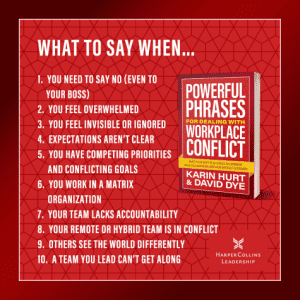
You NEED good conflict to get smarter, more innovative, and to make better decisions.
What you DON’T NEED is the drama and stress of not knowing what to say. Or, the anxiety you feel moments after you’ve said words you regret.
Care-filled words matter. And we’ve spent the last few years researching, crafting, and testing the best ones for you, so you know what to say when work gets wonky.
But before we tell you more about why you should read our new book, Powerful Phrases for Dealing With Workplace Conflict, let’s give you an extra dose of courage to have that conversation you would rather avoid.
Avoiding conflict…1. Wastes timeWhen we asked participants in our workplace conflict research and courageous leadership programs to reflect on past conflicts, we heard many tales of wasted time. “I wish I had talked about it, or talked about it sooner.”
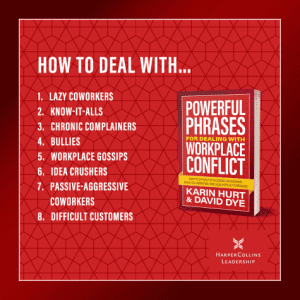 Time wasted…worrying, avoiding, and restlessly flipping the pillow to the cool side. Meanwhile, if nothing changes, nothing changes.
Time wasted…worrying, avoiding, and restlessly flipping the pillow to the cool side. Meanwhile, if nothing changes, nothing changes.
If you’re like so many people in our research, you’re sick and tired of being sick and tired. Change and uncertainty are exhausting. Clarity is the antidote to uncertainty. The best way to align on clear expectations is to talk about them, not engage in magical thinking that everyone “should” know.
3. Destroys relationshipsYou don’t need to sweat the small stuff. Sometimes you need to channel your inner Elsa and “Let it go.”
But, if you avoid the conversation on the big stuff, you’re not doing your relationship any favors. When you refuse to talk about something that matters, you’re sending a signal that you don’t care enough (or trust the relationship enough) to engage in this conversation.
4. Crushes InnovationImagine if every time someone had a new idea, they swallowed it because they were scared of a naysayer. That’s your office without conflict. Without the chance to air and share these ideas, your next big breakthrough might be the one that got away.
Note: If you’ve been following us for a minute, you know we’re all about building cultures where people feel safe and encouraged to share their ideas. Powerful Phrases empowers everyone with the words they need to support your Courageous Culture.
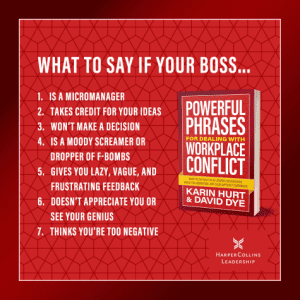
Because conflict is hard.
You probably didn’t learn practical, productive approaches to conflict in school. And, if you’re like most of us, you grew up watching role models really screw it up. You’ve had some conflicts not go well yourself, and you don’t like how that feels. We hate that feeling too.
That’s why we wrote Powerful Phrases for Dealing With Workplace Conflict. To give you practical communication techniques to successfully navigate conflict at work. And when you do, you’ll get better you’ll get better results, build trust, have more influence, and collaborate better with your coworkers.
For more, watch our recent interview on WTOL11 below.

When Tim, our publisher, called and said, “Hey, we need a book to help people deal with today’s challenging and complex workplace conflicts. Want to write it?” our first reaction was, “Yeah, sure. Makes sense. We can do that.”
After all, we’ve been traveling the world shoving all brands of “diaper genies” into overhead compartments of planes for nearly a decade. (“Don’t worry, it’s clean,” we always assure the surprised flight attendant.) And we’ve spent many hours walking jet-lagged around the streets the night before a keynote asking, “Hast du einen windeleimer?” or “Yoˇu mài niàobù toˇng de ma?” (Do you have a diaper pail for sale?) 
If you’re not familiar with these stink-containing contraptions, you take a stinky diaper, put it in the genie, give it a twist, and plastic envelops the diaper so tight it doesn’t stink. But, of course, the stink is still there, which you know if you’ve ever had the pleasure of emptying one of those long plastic-wrapped bundles of joy.
We’re big believers that with workplace conflict, if you can’t smell it, you can’t solve it. And while we think these contraptions are a great invention for parents and babies, metaphorical genies can derail your influence and impact and destroy trust. So, “Yes, let’s do it” was our first answer.
But, when we thought more deeply about actually writing the book, we had to ditch our own metaphorical genie and ask ourselves hard questions. How good are we at navigating conflict at work?
Are we really qualified to write this book? As a married couple writing books together and running an international leadership development firm in the turbulence of a global pandemic and beyond, we’re in a constant dance of conflict and collaboration. A few examples from our conversations with one another:
“I know you really want to take on this new strategic project, but that’s not in our plan. I’ve got a ton on my plate right now, and there’s no way I can do all the things.”
“Hey, don’t you realize how much work went into this? How about a bit more appreciation?”
“Don’t tell me it’s a stupid idea! First of all, it’s brilliant. And would you ever talk to anyone on our team that way? Maybe read your own book on Courageous Cultures and respond with regard the next time.”
Of course, in our “workplace,” the stakes of a mismanaged conflict are high. Disagreements and hurt feelings don’t turn off just because it’s time to go to bed.
Like you, we wish workplace conflict was easier.
And so, we said yes. Not because we do conflict perfectly all the time, but because we know how challenging conflict is and how important it is for you to have practical skills and tools to do this well.
The Conflict and Collaboration Resource CenterOkay, so you’ve ordered your copy of Powerful Phrases, don’t forget to get your companion resources! We’ve built a vault of companion resources to help you build more confident, collaborative, creative (and happier) teams.
Quickly align expectations.Establish habits and norms for working through conflicts.Train your team on practical approaches, before the going gets hard.Talk about your team’s “conflict cocktails” and what you can do about them to make life easier.
We encourage you to use (and share) these resources to support your journey,
When. you love it, will you help us spread the word about Powerful Phrases for Dealing With Workplace Conflict?🎉📚 Got your copy of “Powerful Phrases for Dealing With Workplace Conflict” yet? 🎉📚 Dive into pages filled with strategies for less stress and more effective teamwork. Whether you love to flip through pages, swipe on your Kindle, or listen on the go with Audible, we’ve got you covered! And hey, the voices you’ll hear on Audible? That’s us!
🌟 We need a tiny favor! 🌟 If our book adds wisdom to de-stress your day, would you mind hopping onto Amazon or Goodreads and dropping a review? Each early review is like a high-five for our future readers – it helps spread the word fast!
🔗 It doesn’t have to be anything fancy! Just a sentence or two will do. Your support means the world to us, and it helps keep the good vibes and great advice flowing. Thank you for being awesome! 🌍✨
The post Avoid the Hidden Costs of Workplace Conflict: How Powerful Phrases Will Help Your Team Thrive appeared first on Let's Grow Leaders.
May 10, 2024
The Power of Mental Strength and Fortitude in Leadership
Are you looking for practical ways to implement mental strength, and stay calm under pressure? Don’t miss today’s interview with my friend Scott Mautz.
“Hey Karin. I know that strong leaders stay calm under pressure. And I look at leaders who do this incredibly well. And I want to be that guy (or gal). But it’s hard. What advice do you have to stay calm, regulating my emotions, particularly when times are tough? #askingforafriend

“Mental strength is the ability to regulate your emotions, thoughts, and behaviors for productive outcomes, regardless of the circumstances. Even in adversity. It’s managing internally so you can lead externally.”
How do you become mentally strong, so you can stay calm under pressure?
“If you are able to build the habits to increase your mental strength, it’s like the cheat code for achievement.”
The six habits:
1. Fortitude
2. Confidence
3. Boldness
4. Messaging
5. Decision Making
6. Goal Focus
Fortitude is more than just enduring tough situations; it’s about proactive resilience. Think of it as the backbone of your leadership style. It empowers you to not only withstand challenges but also to thrive amidst them. This involves a mixture of patience, grit, and the psychological stamina to face and overcome adversity.
Leaders with this kind of mental strength don’t shy away from difficult decisions; they make them with a clear mind and a steadfast heart, knowing that each challenge is an opportunity to grow and reinforce their team’s confidence and resolve. This quality ensures that you, as a leader, remain a dependable beacon for your team, especially when the waters get rough.
Part of being mentally strong is having the resilience and fortitude to handle all the things that get thrown at you day to day.
Scott talks about the habit of “grindfulness (gratitude combined with mindfulness). Gratitude is not enough, because humans tend to forget to be thankful. “Grindfulness” enables you to take pleasure in the details of everyday life, and then convert that into action about how you feel about the rest of your life.
Build Your Adversity ManifestoI love Scott’s idea of building an Adversity Manifesto. Write down 5 ways you’re going to show up when things get bad.
For example, you can count on me to stay calm under pressure. I won’t point fingers. I’ll listen. You set the expectation that it’s not a matter of if adversity is coming is when. And the expectation of you how you’ll show up.
You can invite your team to hold you accountable to that. And, also to make commitments to others of how they’ll show up as well.
I’m curious what would you add? What habits do you put in place to show mental strength and stay calm under pressure?
The post The Power of Mental Strength and Fortitude in Leadership appeared first on Let's Grow Leaders.
Breaking Free from Micromanagement Through Effective Communication
Episode 256: Do you have a micromanager as a boss—what do you do to combat micromanagement? Tune in to this episode for some go-to phrases you can use to improve the relationship and keep the interactions at work positive. Host, David Dye, gives you a sneak peek at their new book, “Powerful Phrases for Dealing with Workplace Conflict.” If your whole team needs a copy, there’s a great deal waiting for you. Plus, David tackles a listener’s tough question about leading a team through supervisor changes. You’ll get solid advice on fostering trust and nailing communication with your manager.
Mastering Micromanagement: Expert Strategies to Navigate and Negotiate Overbearing SupervisionUnderstanding Micromanagement00-00:30 – Let’s start with a deep dive into why bosses micromanage. Ever felt like someone’s constantly looking over your shoulder? Well, you’re not alone.
00:31-05:00 – How do you spot a micromanager? Those endless check-ins and updates? Big red flags.
Handling Your Boss05:01-10:00 – Here’s where you find out exactly what to say to your micromanaging boss. “I appreciate your guidance, but I’ve got this covered” might just do the trick.
10:01:15:00 – It’s all about setting boundaries. You’ll get phrases that help you keep your cool and your autonomy.
15:01-20:00 – Wondering how to keep things positive at work despite the tight reins? David shares some tips.
20:01-25:00 – Coming soon—”Powerful Phrases for Dealing with Workplace Conflict.”
Building and Leading a Team25:01-30:00 – Switching gears, David is answering a listener’s question about stepping into a team with a history of many supervisors. Building trust starts with open communication.
31:01-35:00 – Learn how to establish yourself as a new leader without stepping on toes or micro-managing. A must-hear for anyone in a leadership role!
35:01-40:00 – A listener asked about keeping team morale high amid changes and avoiding micromanagement. Here’s professional advice on keeping everyone engaged and motivated.
40:01-45:00 – Don’t miss this deal—bulk purchases of “Powerful Phrases for Dealing with Workplace Conflict” comes with a discount. Perfect for your whole organization to get a handle on workplace challenges.
The post Breaking Free from Micromanagement Through Effective Communication appeared first on Let's Grow Leaders.
May 6, 2024
Magic Mom Words: Powerful Phrases to Move From Mayhem to Magic
(and Yourself)
Whenever we do a media interview about our new book, Powerful Phrases for Dealing with Workplace Conflict, the interviewer or audience member inevitably says,”You know. These phrases would work wonders with my kids.”
Yes. They sure will. Particularly the G.O.A.T.s. (Greatest of All Time, top 12). I’m a big believer in talking to your kids more like grown-ups.
This got me and my friend, Kiersten Lortz talking about additional Powerful Phrases moms (and dads) can use when the going gets rough with their kids. So I gave her the 4 dimensions of productive conflict and invited her to offer some “magic mom words” from her experience as a mom (who has been through a lot), a coach, and an inspiring women’s conference organizer.
So in honor of Mother’s Day, we share a few of Kiersten Lortz’s, magic mom words to de-stress your day, build collaboration, and calm cranky kids (see her amazing credentials at the bottom of this article). See Also: Why Moms Make Amazing Leaders.

Connection starts with those affirmations you whisper to yourself in the bathroom mirror (or shout over the sound of your kids arguing about who stuffed what up the other one’s nose). Saying (and believing) affirmations like “I am bold, I am strong, I am courageous,” helps you connect to your strengths.
And to connect with your kids, keep the channels open. Asking questions like, “It sounds like you’re feeling______, how can I help?” can be a game changer. Even though “because I said so,” is oh so tempting, most of the time “I hear you” is a better choice 😉
Powerful Affirmations to Align with Your Authentic Desires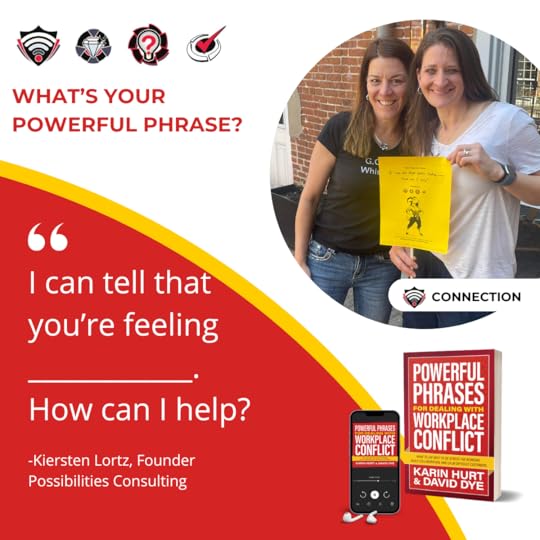 I am bold, I am strong, I am courageous.I desire a day that’s productive AND joyful.I will stop judging the ways I fall short, and focus on what I can improve.What activities/projects/etc help me feel most like myself?For Your FamilyIt sounds like you’re feeling__________, how can I help?I hear you saying___________, what are you looking for from me?I’m proud of who you are and the choices you make.I’m glad I get to be your mom.
I am bold, I am strong, I am courageous.I desire a day that’s productive AND joyful.I will stop judging the ways I fall short, and focus on what I can improve.What activities/projects/etc help me feel most like myself?For Your FamilyIt sounds like you’re feeling__________, how can I help?I hear you saying___________, what are you looking for from me?I’m proud of who you are and the choices you make.I’m glad I get to be your mom. Powerful Phrases to Create Clarity for Yourself and Your FamilyClarity: Do we have a shared understanding of success?
Powerful Phrases to Create Clarity for Yourself and Your FamilyClarity: Do we have a shared understanding of success?Next up, clarity—because understanding what you really want can be as elusive as a quiet bathroom break. Question yourself: “Do I really want to do this or do I feel obligated?” Whether it’s signing up for another school fundraiser or agreeing to host the next family reunion on top of your day job, knowing your limits is key.
And for the love of peace, help your family find clarity too, with questions like, “What’s the most important thing you can do this afternoon? Clarity of shared purpose is a great way to connect with your kids.
Powerful Questions to Create Clarity for YourselfDo I really want to do this or do I feel obligated to do it?At this moment, which is more important, family or work?Is there something I can do that would make other things easier?How do I want to spend my days? Am I doing what brings me joy?What parameters can I put around my time so I can be fully present?Magic Mom Words to Create Clarity for Your FamilyWhat’s the most important thing you can do this afternoon?This is why I do the work that I do.__________ (insert important thing here) is very important this week. Let’s talk about what we can all do to make this a priority. Important Questions to Show Up CuriousCuriosity: Are we genuinely interested in other perspectives and what’s possible?
Important Questions to Show Up CuriousCuriosity: Are we genuinely interested in other perspectives and what’s possible?Phrases like “That’s an interesting thought. What made you come to that conclusion?” lead to discoveries about deeper motivations.
Powerful Phrases to Get Curious About YouIf I could pursue a new hobby/interest/skill, what would it be?Where do I see myself in 5 years? Is that where I want to be?If not, what needs to change?Am I careful with my tone in addition to my words? What does my tone convey to my family?Powerful Phrase to Show Up Curious with Your FamilyTell me more. (Note: As it turns out, this is one of our Connection G.O.A.T. Powerful Phrases as well).That’s an interesting thought. What made you come to that conclusion? Why do you feel that way?What’s one thing I can do to be a better mom? Magic Mom Words to Build CommitmentCommitment: Do we have a clear agreement?
Magic Mom Words to Build CommitmentCommitment: Do we have a clear agreement?Commitment powerful phrases are all about making and keeping shared agreements. Creating mutual shared accountability is one of the fastest ways to reduce family stress.
Powerful Phrases to Ask YourselfDo I keep commitments to myself as well as I keep commitments to others?If not, why do I come through for others but not myself?I will begin setting goals which are attainable and reasonable to set myself up for success and generate wins.Powerful Phrases to Create Shared Agreement with Your Family“What do you need by when?“I’m counting on you to do this by tomorrow afternoon.”“If you want me to come, I will be there. Would you like me to come? Would you like me to be there? Be a part of that event/field trip/etc.?”Let’s schedule a time to talk about this again.These magic mom words are powerful and tender. Let them be bridges that connect, walls that protect, and seeds that grow the future. As you use these phrases, you are not just speaking; you are crafting the heart and soul of your home and your lives together. .
We’d love to hear from you! What are your magic mom words for creating connection, clarity, curiosity, and commitment for yourself and your family?
See Also: Developing Leadership Skills in Children: 11 Ways to Grow Grow Your Kids
Children’s Books on Leadership
About Kiersten Lortz Kiersten Lortz is an accomplished coach, speaker, author, and musician. She is a purpose and productivity coach for working mothers of tweens through adults through her company, Possibilities Coaching and Consulting LLC, and the founder of Possibilities Conference, an annual event inspiring women to live boldly and authentically. Her Time To Thrive coaching program gives women a clear path to overcome the overwhelm and increase mental bandwidth. Kiersten holds a degree in Violin Performance and worked for 25 years as a professional performer and teacher. She enjoys cooking, baking, travel, reading, and studying Japanese. She and her husband, Tim, are the parents of four crazy kids and live in Maryland.
Kiersten Lortz is an accomplished coach, speaker, author, and musician. She is a purpose and productivity coach for working mothers of tweens through adults through her company, Possibilities Coaching and Consulting LLC, and the founder of Possibilities Conference, an annual event inspiring women to live boldly and authentically. Her Time To Thrive coaching program gives women a clear path to overcome the overwhelm and increase mental bandwidth. Kiersten holds a degree in Violin Performance and worked for 25 years as a professional performer and teacher. She enjoys cooking, baking, travel, reading, and studying Japanese. She and her husband, Tim, are the parents of four crazy kids and live in Maryland.
The post Magic Mom Words: Powerful Phrases to Move From Mayhem to Magic appeared first on Let's Grow Leaders.
May 3, 2024
Simple Strategies for Resolving Conflict And Unlocking Team Potential
Episode 255: In this episode, you’ll dive into the challenges of unlocking team potential when leading a team tangled in conflict. Imagine having a handbook of exactly what to say to calm the storm—that’s what the book, “Powerful Phrases for Dealing with Workplace Conflict,” offers you. You’ll hear why it’s crucial to tackle these conflicts head-on, transforming them into opportunities for growth and improved team dynamics. Picture yourself mastering the art of dealing with vents, misunderstandings, and even toxic situations using targeted phrases and strategies. Host, David Dye, also reminds you to keep your eyes on the big picture and not let minor squabbles cloud the team’s goals. Feel free to send in your tricky conflict scenarios for discussion in future episodes and check out the book for more in-depth advice on smoothing over workplace tensions.
Navigating Conflicts to Realize Team Potential: Building Stronger Bonds Through Challenges00:00-01:00 – Have you ever wondered, “Why can’t my team just get along?” We’re unpacking strategies for unlocking team potential in today’s episode.
01:01-02:00 – We kick off by diving into the juicy bits of our new book, “Powerful Phrases for Dealing with Workplace Conflict.” You’ll get a sneak peek at over 300 phrases that can help calm storms at work.
02:01-03:00 – If you’re a fan of audiobooks, guess what? You can hear authors, Karen and David, read the book. Or grab a paperback or ebook. It is time to unlock your teams potential.
03:01-04:00 – Got a sticky situation at work? We would love to hear about it. Send your stories to David.dye@letsgrowleaders.com or drop a voice message on our website. Maybe your challenge will star in our next episode!
04:01-05:00 – We share a personal anecdote about learning to navigate workplace noise and complaints, teaching you that not every moan needs a fix.
05:01-06:00 – As we delve deeper, you’ll learn how to turn these everyday grievances into opportunities for personal and team growth- unlocking your teams potential.
06:01-07:00 – Facing a team that’s always at odds can seem like wading through quicksand, right? Today, we’ll show you how it’s actually a golden chance to boost morale and productivity.
07:01-08:00 – We discuss specific phrases you can use when faced with different types of conflict. Whether someone needs to vent, or there’s a misunderstanding, we’ve got the phrases that make a difference.
08:01-09:00 – And what if the conflict is just toxic? We talk about taking a firm stand, because sometimes, you just need to say, “Not happening here.”
09:01-10:00 – Before we wrap up, remember this: If you find the tips helpful, grab a copy of our book for your whole team. And stay tuned! More powerful insights are on the way in upcoming episodes.
The post Simple Strategies for Resolving Conflict And Unlocking Team Potential appeared first on Let's Grow Leaders.

